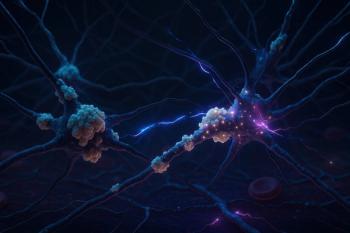
PET Shines Light on Early-Stage Alzheimer Disease
The goal of clinically relevant detection of neuropathological hallmarks may be in sight.
RESEARCH UPDATE
Clinically relevant detection of the neuropathological hallmarks of early-stage Alzheimer disease (AD) in living patients has been an ongoing challenge. Recent findings suggest that while challenges stubbornly persist, a glimmer of a finish line is in sight. \
Although a recent study showed that the plasma concentration of free amyloid-beta (Aβ) is not a biomarker of AD,1 results of a phase 3 clinical trial of [18F]flutemetamol positron emission tomography (PET) demonstrate high specificity and sensitivity for detection of Aβ pathology and potential clinical use in evaluation of neuritic plaque burden.2
Free amyloid-beta plasma concentration
The
The aim was to determine concentrations of free plasma Aβ40 and Aβ42; however, the investigators found no difference in Aβ concentrations between preclinical AD cases and dementia-free controls or difference in concentrations before and after diagnosis among subjects for whom longitudinal data were available. Thus, the researchers concluded that free plasma Aβ was not a viable diagnostic biomarker of AD.
PET imaging
The phase 3 clinical
Also see:
Building a Better Older Brain
More relevant to diagnostic research and drug testing would be study in patients with incipient disease development. The team noted that subjects with a limited life expectancy unrelated to cognitive status-such as elderly cancer patients who may or may not have moderate AD pathology-would be a useful study population. The current trial did just that; it comparatively examined a broad spectrum of Aβ pathology in subjects with AD as well as those with other dementing and nondementing illnesses.
The
Of the 106 brains, 76 (72%) were determined to be abnormal, and, of these, a neuropathic diagnosis of AD was made in 66, although only half of this population had “pure” AD not admixed with other dementia-related illnesses. The tracer technology showed 91% sensitivity and 90% specificity for detection of moderate or frequent neuritic plaques. The probability of an abnormal PET scan correlated with the degree of neocortical plaque density and AD diagnosis, and all non–AD-associated dementia cases as well as cases lacking histopathological signs of Aβ deposits were [18F]flutemetamol-negative.
The bottom line
The findings confirmed that [18F]flutemetamol has high specificity and sensitivity for Aβ pathology and detection of neuritic plaque burden and that an AD diagnosis could be distinguished from other dementing illnesses in the large majority of cases examined. The study authors noted that the utility of the technology would largely be to rule out AD and perhaps provide a more sensitive assessment of AD progression.
References:
1. Lövheim H, Elgh F, Johansson A, et al.
2. Ikonomovic MD, Buckley CJ, Heurling K, et al.
Newsletter
Receive trusted psychiatric news, expert analysis, and clinical insights — subscribe today to support your practice and your patients.














